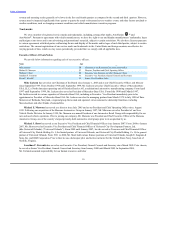AutoNation 2006 Annual Report Download - page 21
Download and view the complete annual report
Please find page 21 of the 2006 AutoNation annual report below. You can navigate through the pages in the report by either clicking on the pages listed below, or by using the keyword search tool below to find specific information within the annual report.
Table of Contents
MANAGEMENT’S DISCUSSION AND ANALYSIS OF FINANCIAL CONDITION AND RESULTS OF
OPERATIONS
You should read the following discussion in conjunction with Part I, including matters set forth in the “Risk Factors” section of this
Form 10-K, and our Consolidated Financial Statements and notes thereto included elsewhere in this Form 10-K.
Certain reclassifications of amounts previously reported have been made to the accompanying Consolidated Financial Statements in
order to maintain consistency and comparability between periods presented.
AutoNation, Inc., through its subsidiaries, is the largest automotive retailer in the United States. As of December 31, 2006, we
owned and operated 331 new vehicle franchises from 257 dealerships located in major metropolitan markets, predominantly in the
Sunbelt region of the United States. Our stores, which we believe include some of the most recognizable and well known in our key
markets, sell 37 different brands of new vehicles. The core brands of vehicles that we sell, representing more than 90% of the new
vehicles that we sold in 2006, are manufactured by Ford, General Motors, Daimler Chrysler, Toyota, Nissan, Honda and BMW.
We operate in a single operating and reporting segment, automotive retailing. We offer a diversified range of automotive products and
services, including new vehicles, used vehicles, vehicle maintenance and repair services, vehicle parts, extended service contracts, vehicle
protection products and other aftermarket products. We also arrange financing for vehicle purchases through third-party finance sources.
We believe that the significant scale of our operations and the quality of our managerial talent allow us to achieve efficiencies in our key
markets by, among other things, leveraging our market brands and advertising, improving asset management, driving common processes
and increasing productivity across all of our stores.
New vehicle sales account for approximately 60% of our total revenue, but less than 30% of our total gross margin. Our parts and
service and finance and insurance operations, while comprising less than 20% of total revenue, contribute approximately 60% of our
gross margin. We believe that many factors affect sales of new vehicles and retailers’ gross profit margins in the United States and in our
particular geographic markets, including the economy, inflation, recession or economic slowdown, consumer confidence, housing
markets, the level of manufacturers’ production capacity, manufacturer incentives (and consumers’ reaction to such offers), intense
industry competition, interest rates, the prospects of war, other international conflicts or terrorist attacks, severe weather conditions, the
level of personal discretionary spending, product quality, affordability and innovation, fuel prices, credit availability, unemployment
rates, the number of consumers whose vehicle leases are expiring, and the length of consumer loans on existing vehicles. Increases in
interest rates could significantly impact industry new vehicle sales and vehicle affordability, due to the direct relationship between higher
rates and higher monthly loan payments, a critical factor for many vehicle buyers, and the impact higher rates can have on customers’
borrowing capacity and disposable income. Sales of certain new vehicles, particularly larger trucks and sports utility vehicles that
historically have provided us with higher gross margins, also could be impacted adversely by significant increases in fuel prices.
The automotive retail environment was challenging in 2006 compared to 2005 especially in California and Florida where the housing
markets experienced a significant decline. In 2006, we saw continued declines in our domestic new vehicle business and a continued
revenue shift in our brand mix from domestic brands to volume import and premium luxury brands. Additionally, we saw a significant
decline in non-luxury truck sales, which we believe is attributable to economic issues. For 2007, we anticipate that the automotive retail
market will remain challenging and that full-year industry new vehicle sales will decline to the low-16 million unit level. However, the
level of retail sales for 2007 is very difficult to predict.
For the years ended December 31, 2006 and 2005, we had net income from continuing operations of $331.4 million and
$396.9 million, respectively, and diluted earnings per share from continuing operations of $1.45 and $1.48, respectively. Our 2006
results were positively impacted by increased gross profits in parts and service and finance and insurance, offset by lower used vehicle
gross profit, higher floorplan and other interest expense and $15.2 million ($9.3 million after-tax) of stock option expense related to the
implementation of Statement of
20
























